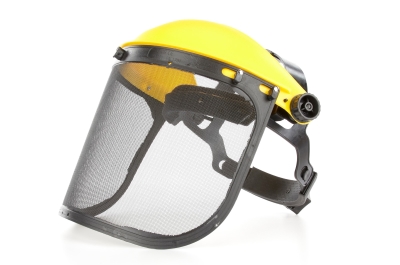PPE Focus: Face Shields For Workplace Injury Prevention
We talk a lot about eye safety and eye protection when dealing with hazards like sparks, debris, or splashing chemicals, and focus on safety glasses and goggles as an important part of our personal protective equipment (PPE). This makes sense – our eyes are easily damaged, and becoming blinded from a work injury has significant repercussions for the injured employee and for the employer.
In our focus on protecting our eyes, though, let’s not lose sight of the fact that more than just our eyes need to be, and can be, protected. Many tasks require the use of face shields, too. They provide additional protection for our eyes, and protect the rest of our face as well. With that said, there are some things that we need to understand about what face shields can and cannot do.
 What Face Shields Do
What Face Shields Do
When properly used as part of a workplace injury prevention program, face shields provide additional protection against some impact hazards, or things flying into our faces. Do pay attention to the word ‘additional,’ though; when used on their own, OSHA does not consider face shields to be adequate protection for impact hazards like flying fragments or objects, large chips, or particles.
To adequately protect an employee from those hazards, a face shield must be used with safety glasses or safety goggles. That’s right – 2 layers of protection. And if you think about it, it seems reasonable – the face shield can slow or even stop a flying hazard before it even reaches your glasses, which are within an inch of your eye. That’s a little close for comfort. A big part of why a face shield isn’t enough on its own, though, is that it doesn’t sit as close to your face or eyes, and so there is still potential for something to fly under the shield and injure your eyes. When combined with safety glasses or goggles, a face shield provides an important additional layer of protection not just for your eyes, but also protects the rest of your face from burns, cuts, or even exposures to toxic or caustic chemicals.
Selecting Face Shields
Like other PPE, we need to select the right face shield for the task at hand. To do so, we need to understand what options are available, what kind of protection is required, and how it will interact with other required PPE used for workplace injury prevention.
One of the most important decisions comes down to selecting the right type of window (also called a visor) on the face shield. Many are available in different types of plastic or plastic-like materials. These often provide excellent visibility for the worker, are usually lightweight (reducing the strain on the worker’s head and neck), and can even be ANSI rated for impact protection.
The materials don’t all function the same, though. Some of these materials are more scratch resistant than others. Some provide adequate protection against specific chemical exposures, whereas others may provide none, or worse, might interact with specific chemicals in dangerous ways. Keep that in mind when selecting face shields to protect against chemical splashes, and make sure to consult your safety data sheets for the chemicals that you use to make sure that your face shields are made of the right materials.
Plastic or plastic-like materials aren’t necessary, or even ideal, for all tasks though. Steel and nylon mesh windows are also available, protecting workers against impacts from larger objects. They won’t provide the same level of protection against dusts, fumes, and vapors, though, as they do not form a solid shield, allowing dusts and vapors to pass through the mesh. That same mesh design allows for even greater airflow for the worker, which can be particularly useful when working outside in the heat.
Other required PPE can also affect what types of face shields are appropriate. One common type is attaches to hard hats, allowing employees to wear adequate head protection. When hard hats are not required, face shields are also available as adjustable headgear. Decisions on which type to use will depend on your PPE assessment, which makes it essential that a thorough analysis is performed so that employees have adequate PPE for workplace injury prevention, so that using face shields does not expose them to additional hazards.
Face Shields For Specific Tasks
There are also specialty face shields designed for specific jobs, and designed to meet OSHA standards for workplace injury prevention against hazards unique to those job tasks. Examples include face shields designed to protect against arc flash when performing electrical work, and that meet the National Fire Protection Association (NFPA) 70E standard. Others protect against heat and radiation, including shaded face shields that protect a worker’s eyes from the intense light and radiation created when gas welding or cutting.
When providing face shields for our workers, then, it is important that we have a full understanding of the hazards associated with the task being performed and select one that is most appropriate for the task. After all, we require them to perform work that exposes them to hazards that they would not usually face, so it is only right that we do what we can to protect them from being injured.

 What Face Shields Do
What Face Shields Do





